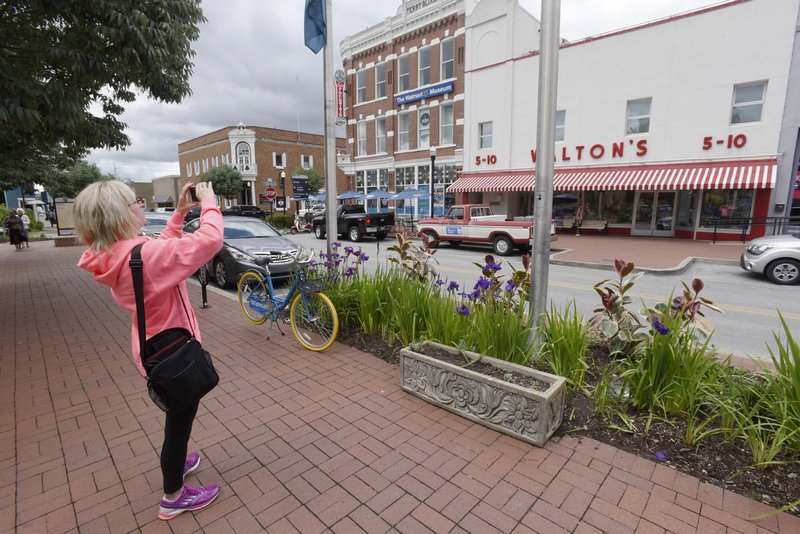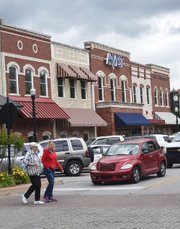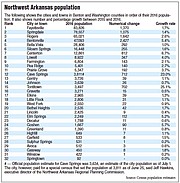Northwest Arkansas’ bedroom communities had the state’s largest growth rates between 2015 and 2016, according to new data from the U.S. Census Bureau.
Tontitown and Cave Springs sit midway between Fayetteville and Bentonville and are in close proximity to Rogers and Springdale. They were the only two cities in Northwest Arkansas to see growth greater than 20 percent in one year.
Rapid growth continues in Bentonville, a former bedroom community that has grown into a destination.
Census data show nearly every city and town in Benton and Washington counties grew between 2015 and 2016.
Northwest Arkansas’ strong population growth helped the state see an increase in year-over-year population despite losses in the Delta and Pine Bluff. Benton and Washington counties grew by 11,256 people. In 2016, Arkansas ranked No. 27 in population growth across the United States, showing growth of 0.3 percent.
Among Northwest Arkansas’ four largest cities, Bentonville added the most residents and had the largest growth rate. Bentonville grew by 5.4 percent in one year, adding 2,247 residents to reach a 2016 population of 47,093.
Rogers saw 2.6 percent growth in its population between 2015 and 2016, followed by Fayetteville at 1.7 percent and Springdale at 1.4 percent.
The proximity to the larger cities contributed to Tontitown and Cave Springs seeing the largest growth rates in the region.
“Rapid growth is continuing to occur in both counties, however the pattern of growth occurring more rapidly in Benton County is expected to continue,” said Jeff Hawkins, executive director of the Northwest Arkansas Regional Planning Commission.
The growth pattern has been from the south to the north, he said. Cities are growing together, so much that Lowell and Johnson now have limited land area for growth, he said.
Until Pinnacle Hills Promenade opened in Rogers in 2006, Fayetteville tended to have more options for entertainment and shopping, said Suzett Sparks, a managing broker for Lindsey & Associates. She’s also president of the 2,330-member Northwest Arkansas Board of Realtors. The opening of the mall began to draw Washington County residents north.
Bentonville transitioned from a bedroom community in recent years with the addition of shops and restaurants and the construction of Crystal Bridges Museum of American Art and the Scott Family Amazeum, she said. Popular areas include the west side of Bentonville and downtown Bentonville, Sparks said.
“It used to be there wasn’t much to do in Benton County,” Sparks said. “If you went to dinner or anywhere, you went to Fayetteville. Now we see people in Fayetteville coming here.”
GROWTH RATES
Only two cities grew by more than 10 percent in one year: Tontitown, with 25.1 percent, and Cave Springs, with 23 percent.
Cave Springs is reaping the benefits of a growing region just as other cities in Northwest Arkansas are, city Alderman Larry Fletcher said. Cave Springs was a town with just little more than 1,900 residents in 2010, with the 2016 count exceeding 3,800 people.
While Cave Springs’ downtown hasn’t changed much, the growth has impacted traffic patterns through neighborhoods, said Fletcher, who has lived there for 15 years.
“It’s a nice community to live in,” he said. “A lot of beautiful homes are being built.”
Managing the growth has come with high points and struggles, he said. A problem facing the city is a lack of infrastructure, including a city sewer system not large enough to handle the expected growth.
Tontitown has maintained its small town atmosphere even as the population has surpassed 3,000, with the U.S. Census Bureau estimating 3,497 residents in the city in 2016, Mayor Paul Colvin said.
Changes to city codes in the past couple of years have created an easier process of building homes, Colvin said. Housing developments are going up on the north and south sides of Henri De Tonti Boulevard, which is also U.S.
412.
Growth is expected to continue, especially with the proximity of Arkansas Children’s Northwest, Colvin said. The children’s hospital is under construction near Arvest Ballpark in Springdale and is scheduled to open in January.
“It makes for a central point for people to live, to travel for work, or entertainment,” he said.
Austin — in the northwest part of Lonoke County on U.S. 167 — was the fastest growing city in the state outside of Northwest Arkansas.
It posted a 9.6 percent population gain in 2016. About 326 new residents call Austin home. In 2000, the Census recorded just 605 residents. In 2010, the head count was 2,038. In 2016, 3,722 residents lived in the city.
“If you don’t want a lot of traffic and everything else, it’s here. It’s quiet. We have a 24-hour a day, seven day a week police protection,” Mayor Bernadette Chamberlain said Wednesday. “We don’t have big Wal-Marts or ‘nuthin. We have a Dollar General. We have day cares. We have a bank.”
Chamberlain, who has been mayor since 1999, said much of her time leading Austin has been managing the growth. She said many of the new residents work at Little Rock Air Force Base.
“We’re a bedroom community, like Cabot used to be to Little Rock,” Chamberlain said. “I guess you want to say we’re the bedroom community now.”
ENCOURAGING GROWTH
Bentonville’s Planning Department stays busy with the number of items going to the Planning Commission for review, said Shelli Kerr, planning services manager.
Much of the development is centered around downtown, Kerr said. Demand has grown for town homes, with 63 permits for town homes skirting the edges of downtown.
Adopting a downtown plan in 2004 preceded the growth, she said. The plan included a goal of increasing the housing density downtown to provide a customer base for downtown businesses and restaurants, she said.
Development activity picked up around 2010, just before Crystal Bridges’ opening, she said.
“Crystal Bridges has a pretty big role to play in a lot of that development activity we’re seeing,” she said.
The growth brought children and families into the schools. Bentonville’s School District this year opened West High School in Centerton in response to growth at Bentonville High School.
Five schools are over capacity and have accommodated students by having a music class meet on stage, an art class meet in a commons area and with the addition of portable buildings to house classrooms, said Tanya Sharp, executive director of student services. Those issues will be resolved next school year when a new elementary school and middle school open.
Annual growth of at least 3.5 percent is expected to continue for the next 10 years, Sharp said. The 2015-16 school year brought 563 more students to the district, followed by 549 more students in the 2016-17 school year.
District officials anticipate 580 students for 2017-18, Sharp said. Growth now is up by 400 even before the new school year, she said. The district has put plans in place to manage the growth over the long term.
“Growth is a good problem to have,” Sharp said. “We do want our district to grow.”
STATE NUMBERS
In central Arkansas, Little Rock continued a trend of modest growth [less than 1 percent], mostly driven by new housing in the western part of Little Rock.
“Little Rock has just developed west,” said Tony Bozynski, director of Planning and Development for the city. “It’s basically gone out the Highway 10 corridor and then the Chenal Parkway corridor.”
He pointed to the city’s latest urban development report.
In 2016, Little Rock netted 196 new single family homes. West Little Rock led the growth with 220 new single family homes. But in east Little Rock, 64 homes were demolished and four were added — a net loss of 60 homes.
For the second year in a row, North Little Rock lost population. The city has 66,278 residents, down 228 from last year. But it still has nearly 4,000 residents more than recorded during the 2010 Census, according to the bureau’s population estimates.
Cities in the Delta continued to lose population. Moro and Aubrey — cities with fewer than 200 residents in Lee County — ranked No. 1 and No. 2 for percent population loss with a 4.6 and 4.5 percent decline respectively.
Marianna, a 20-minute drive east from Moro, ranked third in percent population loss. Its population declined from 3,765 in 2015 to 3,599 in 2016, a 4.4 percent drop.
In terms of the total lost in a single city, Pine Bluff led the state with a 1,140 drop last year. The 2.5 percent decline means the city had 43,841 residents last year. The 2010 Census recorded 49,083 residents.
Brenda Bernet can be reached by email at bbernet@nwadg. com or on Twitter @NWABrenda.




